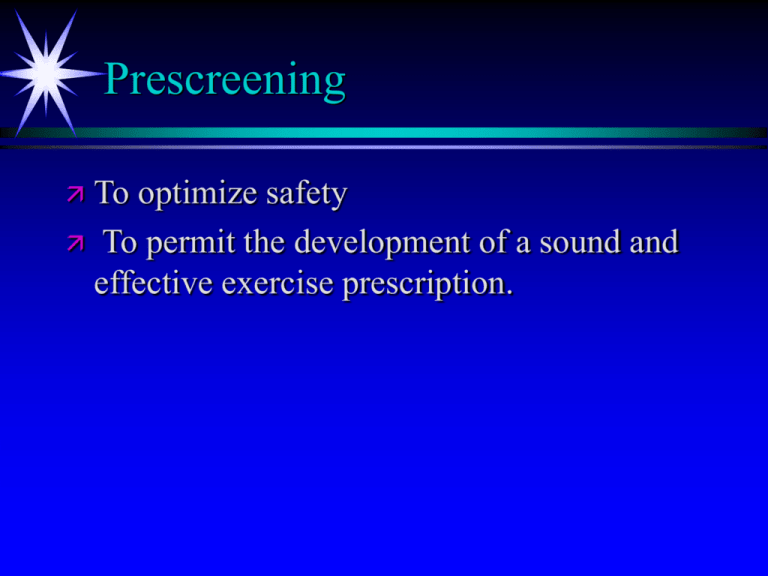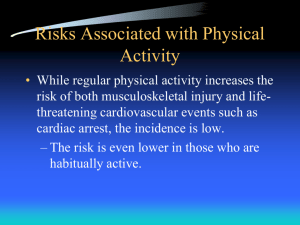Prescreening
advertisement

Prescreening To optimize safety To permit the development of a sound and effective exercise prescription. Prescreening Before assessing your client’s physical fitness profile, you should classify the individual’s health status and lifestyle. Prescreening You will use information from the initial health and lifestyle evaluations to screen clients for physical fitness testing. Prescreening The purpose of the pre-participation health screening include: Identification and exclusion of individuals with medical contraindications to exercise. Prescreening Identification of individuals with disease symptoms and risk factors for disease development who should receive medical evaluation before starting an exercise program. Prescreening Identification of persons with clinically significant disease considerations who should participate in a medically supervised exercise program. Prescreening Identification of individuals with other special needs. Prescreening It is essential that health screening procedures be valid, cost effective, and time efficient. Prescreening The PAR-Q has been recommended as a minimal standard for entry into low-tomoderate intensity exercise programs. Prescreening The PAR-Q was designed to identify the small number of adults for whom physical activity might be inappropriate or those who should have medical advice concerning the most suitable types of activity. Prescreening Prescreening may be composed of: Medical history Risk stratification Medical clearance Prescreening Lifestyle evaluation Informed consent Exercise testing Medical History You should require your clients to complete a comprehensive medical history questionnaire that includes questions concerning personal and family health history. Medical History Use the questionnaire to: Examine the client’s record of personal illnesses, surgeries, and operations. Medical History Assess previous medical diagnoses and signs and symptoms of disease that have occurred within the past year or are currently present. Medical History Analyze your client’s family history of diabetes, heart disease, stroke and hypertension. Medical History Also, when reviewing the medical history, you should carefully focus on conditions that require medical referral. Medical History If any of these conditions are noted, refer your client to a physician for a physical examination and medical clearance prior to exercise testing or starting an exercise program. Medical History It is also important to note the types of medication being used by the client. Medical History Drugs such as digitalis, beta-blockers, diuretics, vasodilators, bronchodilators, and insulin may alter the individual’s heart rate blood pressure, ECG, and exercise capacity. Medical History If your client reports a medical condition or drug that is unfamiliar to you, be certain to consult medical references or a physician to obtain more information before conducting any exercise tests or allowing the client to participate in an exercise program. Medical Clearance Your prospective exercise program participants should obtain a physical examination and a signed medical clearance from a physician, especially if they are: Medical Clearance Men >40 years of age with two or more major coronary risk factors. Medical Clearance Women >50 years of age with two or more major coronary risk factors. Medical Clearance Individuals of any age with known cardiovascular, pulmonary, or metabolic disease. Lifestyle Evaluation Planning a well-rounded physical fitness program for an individual requires that you obtain information about the client’s living habits. Lifestyle Evaluation The lifestyle assessment provides useful information regarding the individual’s risk factor profile. Lifestyle Evaluation Factors such as smoking, lack of physical activity, and diets high in saturated fats or cholesterol increase the risk of CAD atherosclerosis, and hypertension. Lifestyle Evaluation Additionally the lifestyle evaluation should gather information on drug and alcohol use, physical activity level and psychological stress levels of the individual. Lifestyle Evaluation These factors can be used to pinpoint patterns and habits that need modification and to assess the likelihood of the client’s adherence to the exercise program. Risk Stratification See ACSM’s Guidelines for risk factors - p. 18. See ACSM’s Guidelines for risk stratification - p. 19. Informed Consent Prior to conducting any physical fitness tests or exercise programs, you should see that each participant signs an informed consent. Informed Consent This form explains the purpose and nature of each physical fitness test, any inherent risks in the testing, and the expected benefits of the tests. Informed Consent The informed consent also ensures your clients that the results will remain confidential, and that their participation is strictly voluntary. Informed Consent If your client is underage (<18 years), a parent or guardian must also sign the informed consent. Informed Consent All consent forms should be approved by your institutional review board or legal counsel. Risks of Exercise Testing. Clinical exercise testing is a relatively safe procedure, although complications may arise. Risks of Exercise Testing. The risk of death during or immediately after an exercise test is < 0.01%. The risk of MI during or immediately after an exercise tests is < 0.04%. Risks of Exercise Testing. The risk of a complication requiring hospitalization (including MIs) is approximately 0.1%. Risks of Exercise Testing. The data do suggest that the rate of complications during exercise testing is higher in populations undergoing diagnostic testing, compared with persons being tested as part of a preventive medical examination. Risks of Exercise Testing. The risks associated with submaximal physical fitness testing appear to be even lower. Risks of Exercise Testing. Submaximal physical fitness testing appears to have an extremely low risk when accompanied by appropriate pretest screening such as the PAR-Q and can be administered safely by qualified personnel in non-medical settings. Risks of Exercise Testing. No set of guidelines for exercise testing and participation can cover all situations.







